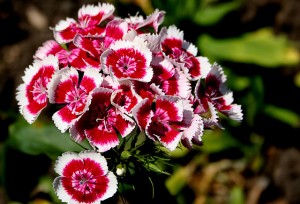Genus: Dianthus
Species: Dianthus barbatus
Common names: sweet-william, carnation Swedish name: bortsnejlika
Dianthus barbatus is native to southern Europe and parts of Asia. The flowers are edible, having a mild flavour and may be used as a garnish for vegetable and fruit salads, cakes, desserts, cold drinks. Many Dianthus species have medicinal properties but this is not investigated in the case of Dianthus barbatus. It attracts bees, birds, and butterflies which makes it suitable for wildlife gardens. How it got its English common name sweet-william is not clear but there are different sayings. The flower symbolizes heroism and courtesy. Catherine Middleton included sweet-william in her bridal bouquet as a tribute to Prince William at their wedding.

Dianthus barbatus. Photo: Marilylle Soveran ©
Description: Dianthus barbatus is a herbaceous biennial or short-lived perennial plant. Wild plants produce red flowers with a white base. There are many cultivars and hybrids selected for differing flower colour, ranging from white, pink, red, and purple to variegated patterns. Some with double flowers. They have a typical spicy, clove-like scent. Dianthus is self-seeding and have the possibility to spread but it is not considered invasive. It is a commonly used plant in cottage gardens (in Swedish mormorsväxt – one of grandmother´s plants).
How to grow: Dianthus barbatus thrives in loamy, slightly alkaline soil with sun to partial shade. It is propagated by seed, cuttings or division. Seeds of cultivars will not look like the parental plants (aka breed true) . If it is planted from seed after the last frost (Spring), it will flower in the second year (biennial behavior). If it is planted before the last frost (Autumn), it may flower in the first year. Some gardeners recommend deadheading to encourage further flowering but then you lose the seeds.
The cottage garden: The distinguishing features of a cottage garden are informality, abundance and diversity. Which is perfect for gardeners engaged in environment and wildlife. The early purpose of the cottage garden was to provide food and flowers were just optional. Therefore there is much to learn from the cottage garden for vegetable and fruit growers. Especially those working in small plots since the original cottage gardens often were quite small. There are no rules which flowers to grow but there are some traditional plants often used. Read more about the cottage garden:
- The 18 Best Plants for Cottage Gardens example of plants you may use
- The Cottage Garden photos, tips and guidelines
- Pam’s English Cottage Garden (in Pennsylvania) a blog with photos, inspiration and that little extra. A treasure for gardeners.
© The photo is licensed by Creative Commons and some rights are reserved. License Attribution 2.0



We had sweet william growing wild around my last apartment. It was so easy to take a small section and replant it in a new location to spread it around. Our Sweet William was purple in color but so lovely. I’d love to head back there and bring some down here to my new home. Maybe I will. 🙂
LikeLike
I hope you will 🙂 Sweet William is so pretty and easy to maintain. A great idea to replant them so they spread!
LikeLike
I love when restaurants garnish dishes with edible flowers. I have seen Dianthus used for that purpose quite a few times!
LikeLike
Lovely! I agree with you. I don’t think I have been served a dish with edible flowers yet. But I look forward to it.
LikeLike
Lots of great info! I didn’t know this was edible.
Yvonne
LikeLike
Thank you Yvonne!
LikeLike
Dianthus is one of my favorites, Charlotte. My grandmother always called it Sweet William. I have not used it as a garnish — I will try it. Thank you for linking to my blog, and for your kind comments. Happy Easter! P. x
LikeLike
Thank you for stopping by Pam. I love Dianthus too. They are so pretty and easy to grow.
LikeLike
They look too pretty to eat, although they would brighten up any plate or salad.
LikeLike
I know – I find it hard to collect flowers. But if you have many it often isn´t noticable if you take one here and there
LikeLike